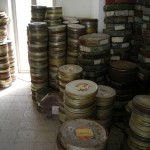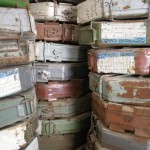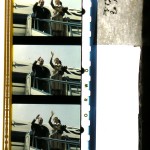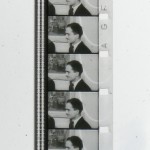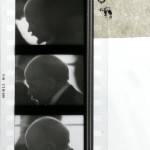Identifying a Trove of Films in Jordan
By Matthew Epler
Aqaba, Jordan –
Almost 900 mysteries wait to be solved at the Royal Film Commission in Amman, Jordan. They are film cans stacked in a garage facing a busy and popular street lined with small markets, workshops, and restaurants. Each day, locals and tourists pass them by without the slightest notion that within them could be (and most likely are) clues of serious cultural significance leading from this dusty garage in Jordan all the way to the U.S.S.R. and back again.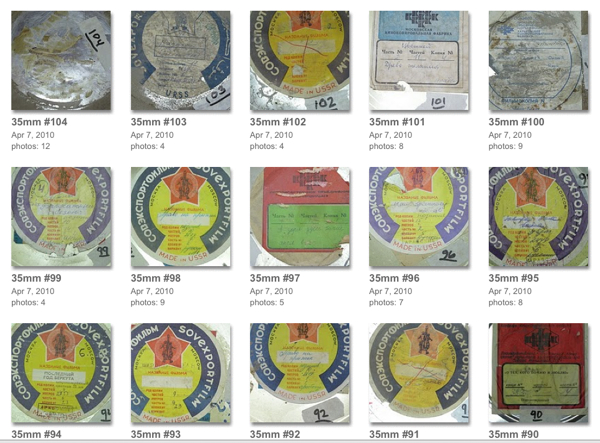
Saved from a trash pile by local artist Ali Maher, these film canisters were found at a now defunct Russian Cultural Center in Amman. The Royal Film Commission Jordan (RFC) was gracious enough to store them temporarily, where they have sat untouched for some time. Then, in the summer of 2009, on my way back to my teaching job in Aqaba at the Red Sea Institute for Cinematic Arts, my colleague Mohannad Bakri mentioned them and asked if I cared to see them. I knew what was going to happen. I was going to enter an obsessive treasure hunt. The challenge of finding out what was hiding in those canisters was an opportunity I could not pass up.
For months thereafter, I tried to negotiate their transfer to a more secure location where they would not suffer through the notoriously hot, dry summers and cold, wet winters of Amman. Mold was growing on the ceiling, and the RFC had already slated the space to be renovated for use as a café. But without knowing if the films were treasures or trash, no one would foot the bill.
As common as it is for institutions to avoid the costly and cumbersome process of trying to save film, it is very uncommon to find films at all in Jordan. With an influx of satellite television and increasing bandwidth reaching homes all over the region, films have already become relics here.
Although there is a growing number of filmmakers in Jordan, the industry still hasn’t taken off (with the exception of Amin Matalqa’s Captain Abu Raed) and few Jordanians are even aware that Jordan has a film history. Long ago, locally owned theatres closed by the dozen and pirated copies of Hollywood blockbusters took over. If these films at the RFC were going to be saved, I had to prove that there was something worth saving.
In the Spring of 2010, I spent five days at the Commission documenting the collection. With the help of my student, Mohammed Shehabi, and a local screenwriter, Naji Abu Nowar, I was able to photograph the lids of all 881 cans. Additionally, I was able to photograph the leader, first image, last image, and tail of 105 of the prints. All of this was done with very crude equipment. I had a point-and-shoot digital camera, two cardboard boxes, a circular fluorescent bathroom light, and some duct tape. It was hot, dusty, and painstaking. In other words, we had a great time.
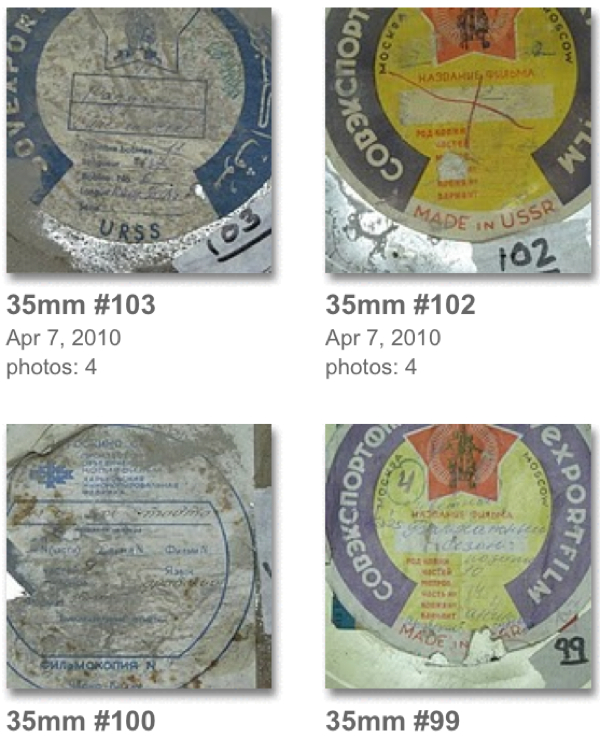
Most of the 35mm prints appear to be Russian fiction features, all of them with Arabic subtitles and sometimes English and French as well. The labels are entirely in Russian, and belong to major studios that existed prior to the dissolution of the U.S.S.R. The 16mm appears to be primarily documentary footage, and those cans are labeled in Arabic by hand. These latter films appear to have been produced locally, a historically significant find for Jordan, but still not enough to prove that we had something truly special.
Then, by chance, I opened a 35mm can and found footage of His Majesty King Hussein, waving from the open door of a Russian jet with his wife, Queen Alia. The footage brought instant attention. The RFC was started and is still overseen by Prince Ali, the son of Queen Alia. In a tragic helicopter accident in 1977, Queen Alia was killed and is still mourned in Jordan to this day. King Hussein died in 1999 as one of the longest-serving leaders in international politics, remembered for his monumental efforts to achieve peace in the Middle East throughout his reign.
{Click on an image to expand}
The more we looked, the more we found. Dates on the Russian films were as far back as the mid-1930’s (although the prints appear to have been made within the last 30 years). There were war epics, costume dramas, even a can labeled “silent.” We found documentary footage of Lenin. Then more of King Hussein, this time in a small 16mm can labeled “Exodus, 1967” which could only be the exodus of Palestinian refugees immediately following the Six-Day War with Israel.
I was out of my depth. I could not read the Russian, and my Arabic was at a cave-man level. I soon realized that I was going to need help, and a lot of it. I decided that an online, collaborative effort would be the best way to get the information in the hands of the people who could tell us what we needed to know. I uploaded 200 cans’ worth of images to a Picasa photo gallery in hopes that amateurs and professionals alike from around the globe could help us solve the mystery of what was in the cans, and how the films came to Jordan.
So many questions remain unanswered. Why were Russian films being screened in Jordan? Who was watching them? What kind of presence did the Russians have culturally in Jordan? Who were these local filmmakers? Are any of these films rare? Are they worth saving?
Despite all our incredible finds, the majority of the collection still remains a mystery. There is still no funding to transport the films to a safe place where they be protected from further deterioration until we can properly analyze them. There is no film archive in Jordan. The French have expressed interest in funding one, and Paolo Cherchi Usai (director of the National Film and Sound Archive of Australia, co-founder of the Pordenone Silent Film Festival and of the L. Jeffrey Selznick School of Film Preservation at George Eastman House, and prolific author on film) recently attended the Abu Dhabi Film Festival hoping to convince investors to build a regional archive, but still no resources exist. And, despite my MacGyver-esque attempts, we have no proper equipment.
If you are interested in helping us translate Russian text, or have connections to persons who may know something about these films and their originating companies, or would like to receive updates on the project, please contact me at the email address below.
n
 Matthew Epler is an instructor of cinema studies and cinema librarian at the Red Sea Institute of Cinematic Arts in Aqaba, Jordan. While studying at the cinema and television critical studies program at the University of Southern California’s School of Cinematic Arts, he founded Depth of Field, a campus journal of cinema studies, arts, and culture. He worked as a projectionist, then in the Los Angeles film industry as an assistant director and producer of short films and music videos. He also produced and directed a feature-length documentary film for Very Special Arts, an international non-profit organization that supports artists with disabilities. He has made experimental films, short films, and installation videos. He designed and taught the two-year filmmaking and film-studies course at Escola Graduada in Sao Paulo, Brazil, before moving to RSICA in Jordan. Contact him at Matthew.epler@rsica.edu.jo and see his collection of photographs of the recovered film canisters.
Matthew Epler is an instructor of cinema studies and cinema librarian at the Red Sea Institute of Cinematic Arts in Aqaba, Jordan. While studying at the cinema and television critical studies program at the University of Southern California’s School of Cinematic Arts, he founded Depth of Field, a campus journal of cinema studies, arts, and culture. He worked as a projectionist, then in the Los Angeles film industry as an assistant director and producer of short films and music videos. He also produced and directed a feature-length documentary film for Very Special Arts, an international non-profit organization that supports artists with disabilities. He has made experimental films, short films, and installation videos. He designed and taught the two-year filmmaking and film-studies course at Escola Graduada in Sao Paulo, Brazil, before moving to RSICA in Jordan. Contact him at Matthew.epler@rsica.edu.jo and see his collection of photographs of the recovered film canisters.
Previous Post: NHPRC and NFPF
Next Post: Afterimage: Call for Papers

